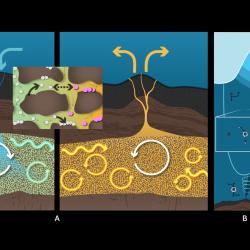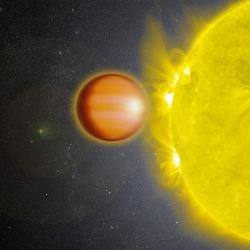Scientists Discover Building Blocks of Life in Ice Around a Forming Star in Neighboring Galaxy
A team led by a University of Maryland astronomer detected large complex organic molecules in ices outside of the Milky Way for the first time, offering a glimpse into the chemistry of the early universe.

In a discovery that could reshape our understanding of how the chemical ingredients for life spread throughout the cosmos, astronomers detected organic molecules with more than six atoms frozen in ice around a young star called ST6 forming in a galaxy outside of the Milky Way.
Using the James Webb Space Telescope’s (JWST) Mid-Infrared Instrument (MIRI), the researchers discovered five different carbon-based compounds in the Large Magellanic Cloud—our nearest galactic neighbor. Led by University of Maryland and NASA research scientist Marta Sewilo, the team detailed its findings in a paper published in the Astrophysical Journal Letters on October 20, 2025.
Sewilo’s team identified five complex organic molecules (COMs) in the ice surrounding the young protostar, many of which can be found right here on Earth: methanol and ethanol (common types of alcohol), methyl formate and acetaldehyde (primarily used as industrial chemicals on Earth) and acetic acid (the main component of vinegar). One of the molecules—acetic acid—has never been conclusively detected before in space ice, while ethanol, methyl formate and acetaldehyde represent the first detections of these COMs in ices outside the Milky Way galaxy. In addition, the team also observed spectral features that resemble another ice COM—glycolaldehyde, a sugar-related molecule and precursor of more complex biomolecules, such as components of RNA; however, further investigation is needed to confirm its detection.

“It's all thanks to JWST’s exceptional sensitivity combined with high angular resolution that we’re able to detect these faint spectral features associated with ices around such a distant protostar. The spectral resolution of JWST is sufficiently high to allow for reliable identifications,” Sewilo noted. “Before Webb, methanol had been the only complex organic molecule conclusively detected in ice around protostars, even in our own galaxy. The exceptional quality of our new observations helped us gather an immense amount of information from a single spectrum, more than we’ve ever had before.”
What makes the team’s discovery particularly remarkable is the challenging environment where the molecules were found. The Large Magellanic Cloud, located about 160,000 light-years away from Earth, serves as a natural laboratory for studying star formation under conditions similar to those in the early universe. The galaxy has roughly one-third to one-half the heavy elements (elements with higher atomic numbers than helium) found in our own solar system and experiences much stronger ultraviolet radiation.
“The low metallicity environment, meaning the reduced abundance of elements heavier than hydrogen and helium, is interesting because it’s similar to galaxies at earlier cosmological epochs,” Sewilo explained. “What we learn in the Large Magellanic Cloud, we can apply to understanding these more distant galaxies from when the universe was much younger. The harsh conditions tell us more about how complex organic chemistry can occur in these primitive environments where much fewer heavy elements like carbon, nitrogen and oxygen are available for chemical reactions.”
Study co-author Will Rocha, a researcher from Leiden University in the Netherlands, noted that COMs can form in both the gas and ices on interstellar dust grains. After their formation, ice COMs can be released to the gases; previously, methanol and methyl formate were detected in the gas-phase in the Large Magellanic Cloud. While the formation process of COMs is still not fully understood, chemical models and lab experiments show that chemical reactions on the surfaces of interstellar dust grains are the main contributor to COM production.
“Our detection of COMs in ices supports these results,” Rocha explained. “The detection of icy COMs in the Large Magellanic Cloud provides evidence that these reactions can produce them effectively in a much harsher environment than in the solar neighborhood.”

Finding icy COMs in similar conditions to those in the early universe suggests that the building blocks for larger biomolecules, important for the emergence of life, were formed much earlier and under a greater variety of cosmic conditions than previously thought.
While the team’s findings do not prove the existence of life beyond Earth, the research suggests that these species could survive the evolution of planetary systems and later be assimilated to early planets once they are formed, where life could flourish. Sewilo plans to expand this work to include more protostars in both the Large Magellanic Cloud and potentially the Small Magellanic Cloud, the next closest galaxy to Earth, and continue to explore questions about the complex chemistry of the universe.
“We currently only have one source in the Large Magellanic Cloud and only four sources with detection of these complex organic molecules in ices in the Milky Way. We need larger samples from both to confirm our initial results that indicate differences in COM abundances between these two galaxies,” Sewilo said. “But with this discovery, we’ve made significant advancements in understanding how complex chemistry emerges in the universe and opening new possibilities for research into how life came to be.”
###
The paper, “Protostars at Subsolar Metallicity: First Detection of Large Solid-State Complex Organic Molecules in the Large Magellanic Cloud,” was published in the Astrophysical Journal Letters on October 20, 2025.
This research was supported by NASA.







